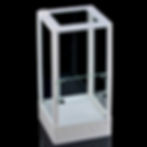Camponotus pennsylvanicus, also known as the "Black Carpenter Ant," is one of the biggest and most common species of Camponotus found in Eastern North America.
They are one of our favourite species to get started with; this is due to them being easy to care for, high adaptability and do not have complex requirements to fulfill; they are big, making them easy to observe, and they can create good size colonies.
As the name states, they have a deep black colour, contrasting with the golden hairs and bands around their gasters. They love to nest in decaying wood, and workers are not afraid to travel long distances looking for food.
They are often found above ground, in tree trunks, logs, stumps, poles, fences, tending to aphids on plants, etc. They are somewhat opportunistic with their nest location as they look for defects in the wood, like holes, crevices, cavities and crotches. This is perhaps the main reason they are often seen as pests, as our wood houses often have the perfect location for them, although they don't destroy healthy wood and prefer rotten or decaying areas. If you see them in your home, that can be a sign of structural damage that was already there.
They are relatively slow in their founding stages and throughout the first year, but generally, colonies expand much faster in their second year onwards; it is also due to this slow start that we recommend them for beginners, as this allows us ant-keepers to learn and explore at a more manageable pace. This species develops much faster if provided with areas with high temperatures; they will move their pupae and cocoons in and out of such areas as needed.
This species requires low humidity (they prefer to have gradients), and our hybrid formicaria will need very little water; they are oligogynous and like to be in tight places, even if the queen can hardly turn inside a 16 mm test tube, that is, the perfect size for them. We also recommend leaving little space between the entrance and the cotton water barrier. They can fit through 9.5 mm tubing, and it is preferred during the founding stage to create a smaller chamber entrance; once the colony is more extensive and has more traffic on their formicarium entrance, it is wise to use 12.7 mm tubing.
Every queen (or starter colony) ships in a pre-assembled test-tube setup. Components are listed in the “Included Queen Test Tube Setup” info section. For the full breakdown of all options and why we use them, see "Test Tube Components Explained".
Live ants ONLY SHIP within CANADA.
Camponotus Pennsylvanicus (Black Carpenter Ant)
Your queen (or starter colony) arrives housed in a pre-assembled test tube setup. The exact components are listed below.
- Borosilicate glass tube measuring (16x125mm)
- Water Chamber System: Long cotton water keeper
- Insert Texture: Plain plastic (35mm long)
- Cone adapter for vinyl tubing: 12.7 mm (1/2")
- Light protection & rings: Black jacket + 2 tall rings
Scientific Name: Camponotus pennsylvanicus
Common Name: Black carpenter ant, common carpenter ant
Distribution: Eastern and Central Canada and United States. Common in the Eastern and Central United States and the lower regions of Canada.
Queen size: 15-18 mm
Worker size: 6-14 mm, polymorphic
Natural Habitat: Normally found in trees, logs and occasionally houses.
Circadian Activity: Primarily nocturnal; however, they will occasionally forage in the daytime.
Mating Flight: Usually the first warm afternoon in Spring. Will fly as early as March and as late as July.
Queen Founding Method: Fully Claustral
Monogyne or Polygyne: Strictly Monogyne
Average time from egg to worker: Egg to larva = 20-30 days; larva to pupa = 10-15 days; Pupa to worker = 18-25 days.
This species grows very slowly. In the beginning, it only takes 1.5-2 months for nanitics, but it takes 2+ months in a normal colony. The average time from egg to worker is highly dependent on temperature. Time is highly dependent on temperature; a higher temperature generally reduces the average time.
Recommended Temperature: 75-80°F (24-27°C)
It is a heat-loving ant, so a heating cable is preferred. Hibernate them at roughly 46-55°F (8-13°C). Queens found in a warmer location might prefer more heat.
Recommended Humidity: Queens found in more desert locations may prefer a lower humidity. Queens found in more temperate locations prefer a higher humidity. Different stages of brood will be kept at different humidity levels.
Preferred Foods: Insects including crickets, termites, fruit flies, house flies, mealworms, spiders and grasshoppers/locusts. Sweets including sugar water, honey, syrup, and a variety of fruits.
This species also has a social stomach, so keep that in mind when it comes to foods. Here is a link to their preferred foods.
Hibernation Details: Requires hibernation. 3-5 months is recommended, depending on where the queen was collected.
Make sure they have access to water and sweets, as they may eat and drink during their hibernation. This species commonly falls over in hibernation and may appear dead until they wake.
Escape Barrier Methods: Fluon and talcum powder are effective at containing them. They are unable to climb upside down on olive oil. Vaseline or olive oil on a vertical surface will not contain them.
Difficulty rating: Great beginner species, but grows quite slowly. This species is good for someone with patience.
Bite and/or Sting rating: They can and will bite, and will likely dab formic acid on the bite. The pain will fade within a few minutes.
Special Care or Interesting Notes: As these are carpenter ants, they are able to chew through soft plastics, plaster, and sometimes a whole cotton ball. Also, these ants are especially susceptible to chemicals. They will require extra ventilation or airflow as they can produce a strong formic acid gas when startled or alarmed. These ants will often appear inactive during the day as they are primarily nocturnal. Colonies with less than 50 workers are far less active than colonies with more than 100 workers.Information source: https://www.formiculture.com/
















